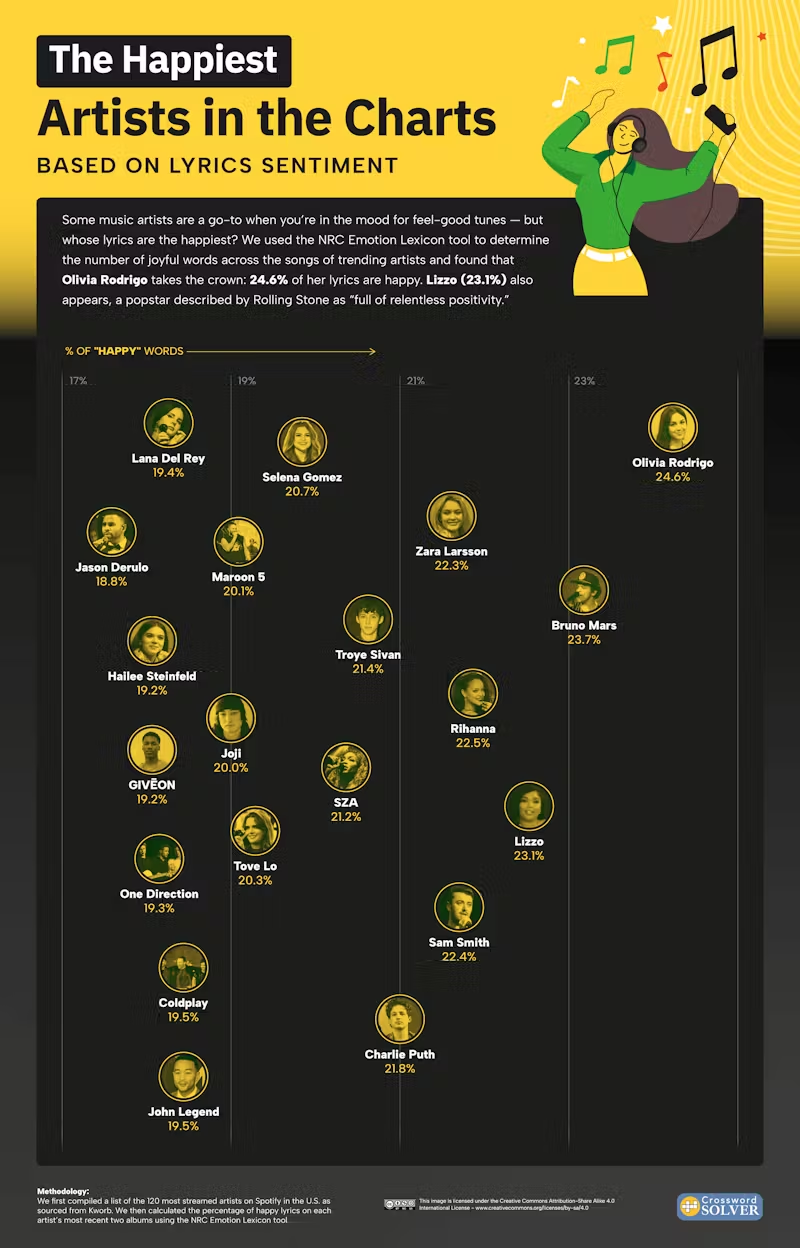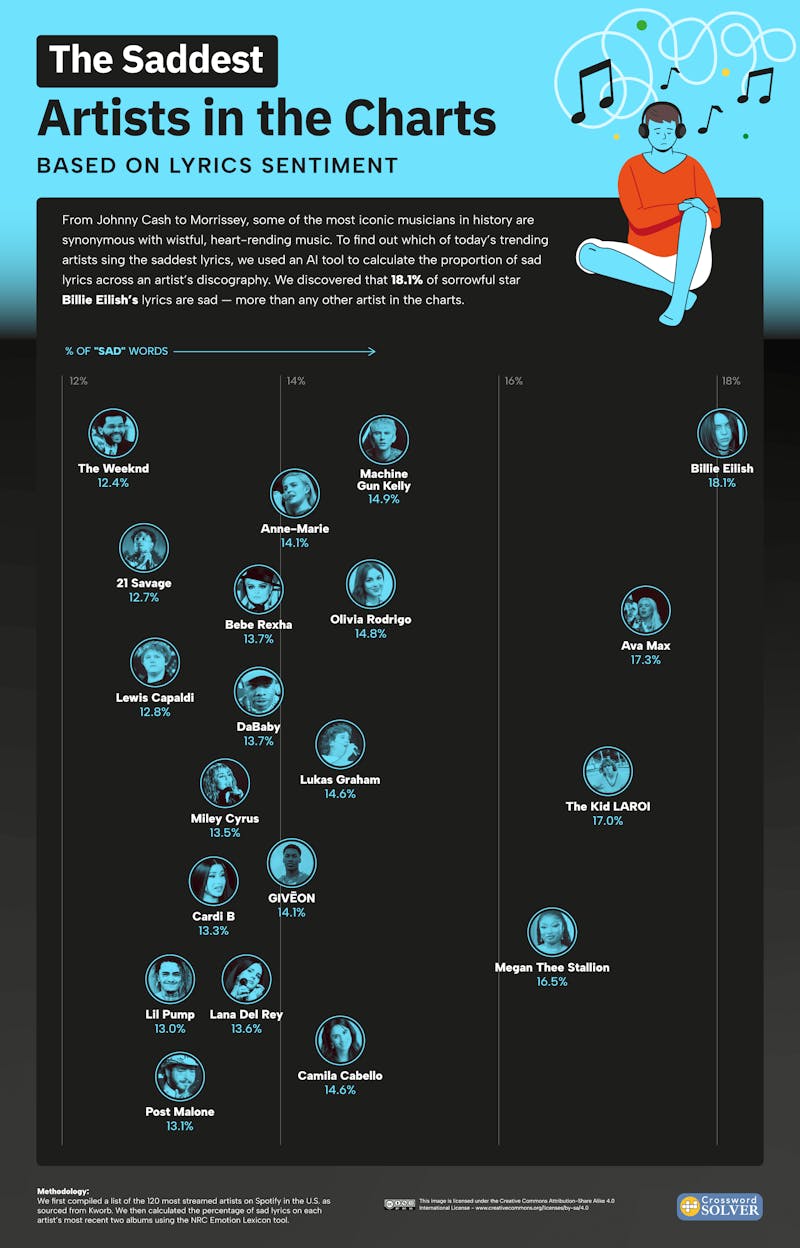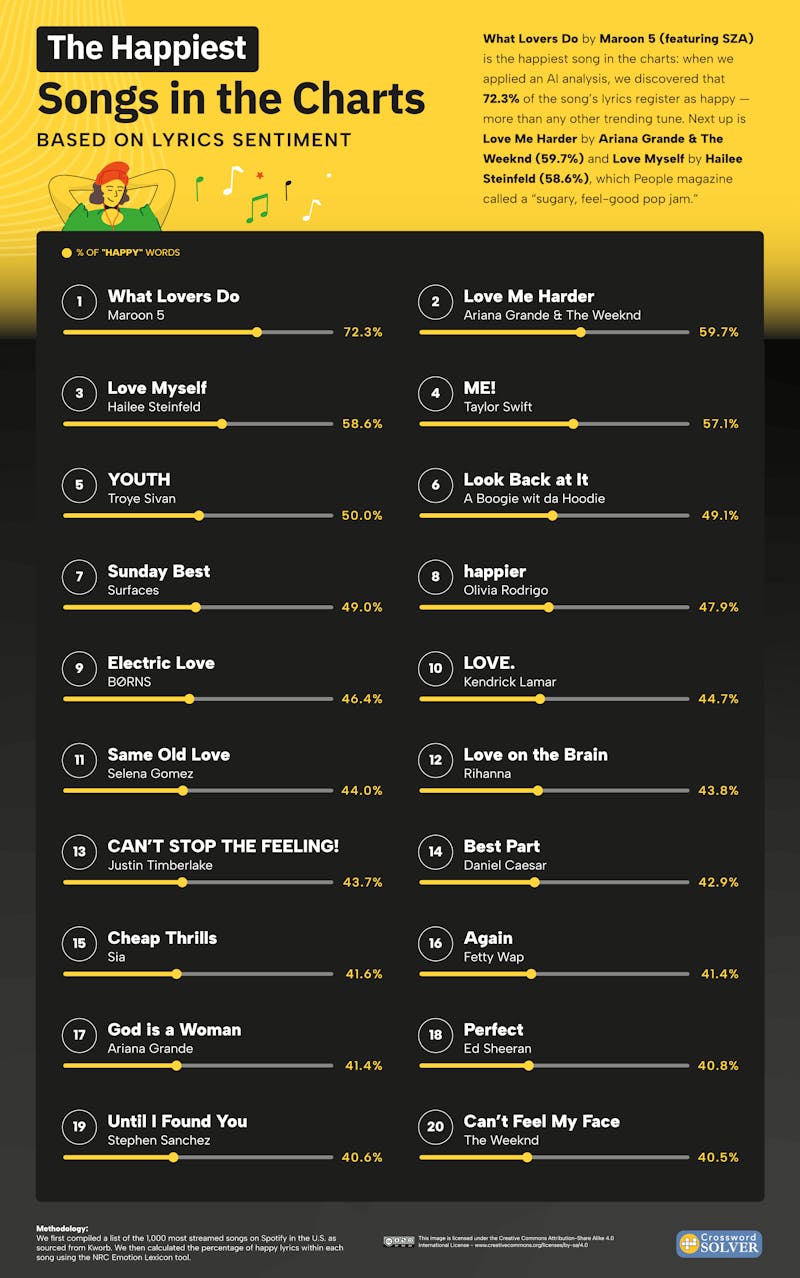The Happiest and Saddest Artists in the Charts, According to Their Lyrics

“It feels so good to hurt so bad,” sang Elton John in his 1984 dissection of the appeal of sad songs. “They reach into your room, just feel their gentle touch…”
Science has got Elton’s back on this. Sad music triggers hormonal changes that are usually reserved for coping with trauma, and induces pleasurable feelings, a hack that record producers are onto. Pop music has been shown to have gotten sadder and sadder since the 1960s.
But there’s another reason why sad songs dominate the airwaves. It is notoriously difficult to write a happy song that is actually good. “It’s easy to write sad songs,” says Noel Gallagher of Oasis. “[But] It’s very difficult pulling off this magic trick of joy and togetherness.”
A perfectly executed happy song can make you feel like you are literally walking on sunshine. It makes a party, whether it’s the banger that brings us to the dancefloor, the summer hit that unites a generation or the Christmas jingle that makes even the most resistant Scrooges feel festive. Get the blend wrong, and you’ll come off looking cheesy, insincere or even gormless.
So, while more complex emotions tend to be left to alternative acts and album artists to ponder, the biggest pop stars of our time have a polarized approach to their craft, aiming to write and release songs that are very happy or very sad, albeit in their own particular flavor. Crossword-Solver decided to wade into the lyrics and find out which of today’s chart acts are the happiest and saddest — and which of their songs are the most emotive of all.
What We Did
Crossword-Solver listed the 120 most streamed artists and 1,000 most streamed songs on Spotify in the U.S., as sourced from Kworb. We then used the NRC Emotion Lexicon tool to calculate the percentage of happy lyrics on each artist’s most recent two albums and each of the 1,000 songs.
Key Findings
- Olivia Rodrigo is the happiest chart artist, with a 24.6% positivity rate in her lyrics.
- Billie Eilish is the saddest star, with 18.1% of the words in her lyrics being sad.
- Maroon 5’s What Lovers Do has a 72.3% positivity rating, making it the happiest song in the charts.
- The saddest song is Kendrick Lamar’s HUMBLE., which is 51.3% sad.
Smiling Through Her Tears, Olivia Rodrigo is Pop’s Happiest Artists
Making the tricky transition from teen TV star to Platinum-selling pop star via accolades such as Time Entertainer of the Year and Billboard’s Woman of the Year, Olivia Rodrigo’s rise would make a great movie montage sequence accompanied by one of our study’s chirpiest tunes. But Rodrigo’s lyrics reveal a truth at the heart of songwriting: the best songs are often bittersweet, sadness tinged with hope or happiness hung with irony.

Rodrigo is known for songs about heartbreak and jealousy, but her happiest — aptly called happier — reveals that smiling through the tears is what makes her work compelling. “Songwriting is the thing I take most seriously in my life,” Rodrigo told Time. “At the core of it, all my songs are about me and my experiences and my feelings.”
With lyrics celebrating the joys of seafood, high-quality bed linen and being attractive, the case for second-happiest Bruno Mars is less complicated.
Billie Eilish is Saddest of Sad Artists
Happier Than Ever? Billie Eilish’s longest song starts out jauntily enough but is far from the triumphant moving-on song it hints at being. Flipping into a nineties-style alt-rock autopsy of a toxic relationship, the title track of her second album exemplifies the angsty complexity that makes her pop’s saddest artist. Eilish has an 18.1% sadness rating across her first two albums but her saddest song, when the party’s over (the one where she cries black tears in the video), has a 45.8% sadness rating.

That Happier Than Ever title echoes the ‘happiest’ song of her contemporary and friend, Olivia Rodrigo (see above), whose lyrics are emotive enough to place her in the top 20 happiest and top 20 saddest artists. A night out on the Guinness with those Eilish and Rodrigo might not make for a barrel of laughs.
Maroon 5’s What Lovers Do is the Happiest Song in the Charts
Four letters, begins with L: people like to be in it, pop stars like to sing about it? Seven of the 20 happiest chart songs use a variation on the word ‘love’ in their title. With its singing deer, heart-shaped butterfly choreography and magic hour photography, Maroon 5’s What Lovers Do is genetically modified to be an upbeat summer banger, even if the lyrics are riddled with doubt.

Similarly specked with magic-realist butterflies and a rainbow palette, Taylor Swift’s ME! is a musical resume selling the strident beat and confidence of a Hollaback Girl or Beyoncé’s End of Time. If writing happy songs risks coming off vacuous, using humor so prominently can be a risky path. But for every listener who finds ME! annoying, there are plenty of Swift loyalists who see its charm. And now science has proven it to be the fourth happiest song, with 57.1% of the words being upbeat.
Kendrick Lamar’s HUMBLE. Is Very Sad, Also Rude
Curse words and insults form the backbone of Kendrick Lamar’s modern take on Letters to a Young Poet. Rather than offer constructive feedback to his big-headed fellow rappers, HUMBLE. finds the hip-hop artist stewing in his own anger and cynicism. The track leads a chart of the saddest songs whose titles likewise fixate on one particular aspect or subcategory of sadness: Supalonely, Falling, Sorry, Revenge, Jealousy and Lost.

Harry Styles might seem to lead a blessed existence, but, in Falling, he’s stuck in his house with his ex-girlfriend’s (locked) suitcases, his favorite café is out of beans and he really needs a plumber. To rub salt in the wound, producer Kid Harpoon turned up to record the song wearing a pair of slippers that Harry’s ex-girlfriend (model and actress Camille Rowe) had given him. It all went into the music, adding up to a whopping 46.4% negativity rating and the fifth saddest song in the charts. “It’s not like I’ve ever sat and done an interview and said, ‘So I was in a relationship, and this is what happened,’ ”says Styles. “Because, for me, music is where I let that cross over.”
Take A Sad Song, Make It Better
Sad sells. Kid Harpoon’s response to recording with Harry Styles through a tough break-up was to remind him of Iggy Pop’s philosophy: only date heartbreakers; they’ll give you the best material. Styles’ response was to create music so simple that even those listeners who don’t know how to play an instrument could imagine themselves sitting at the piano, improvising a mournful dirge note by note. A sad song is an empathy machine for someone the singer doesn’t even know exists.
But happy songs get into our veins — they capture a moment and set the pace for being together and celebrating life’s rich, sometimes absurd, ride. And if pop music as we know it has been around for barely three-quarters of a century, pop stars have yet to exhaust two most fundamental emotions it trades in. Especially since, under the hood, things are rarely as simple as they seem.
METHODOLOGY & SOURCES
We first compiled a list of the 120 most streamed artists and the 1,000 most streamed songs on Spotify in the United States from Kworb.
For each of the 120 artists, we created a list of songs from their two most recently released studio albums. Using Genius, we then gathered the lyrics of all the songs on those albums and detached the language using the langdetect module.
We used NRC Emotion Lexicon to determine the number of joyful and sad words in every song. The NRC Emotion Lexicon is a list of English words and their associations with eight basic emotions (anger, fear, anticipation, trust, surprise, sadness, joy and disgust) and two sentiments (negative and positive).
This allowed us to rank artists and songs based on the highest percentage of “joyful” words (the happiest) and highest percentage of “sad” words (the saddest).
The data was collected in November 2022.
Recent Clues
- Well-suited Crossword Clue
- Vaulted area Crossword Clue
- Limb with an elbow Crossword Clue
- Not approximate, say Crossword Clue
- Medicinal plants; a sole (anag.) Crossword Clue
- Went quickly over part for recital Crossword Clue
- River bird catches swallow (5,4) Crossword Clue
- Fish eggs (3) Crossword Clue
- Oil org. Crossword Clue
- Event cited in an insurance policy Crossword Clue
- A law -- itself Crossword Clue
- Animal of a breed of large white beef cattle that originated around Charolles in France (9) Crossword Clue
- Outstanding saltine crackers (7) Crossword Clue
- Hair growth option Crossword Clue
- "The Wizard of Oz" dog Crossword Clue
- ___ in your step Crossword Clue
- Titled women Crossword Clue
- Service providers in Scottish town protected by those in charge Crossword Clue
- Express weariness Crossword Clue
- Plunder Crossword Clue
- clue Crossword Clue
- Snails' exteriors Crossword Clue
- Good Friday fare Crossword Clue
- French aperitif Crossword Clue
- Atlantic or Pacific Crossword Clue
- Scrooge Crossword Clue
- L-P link Crossword Clue
- Place for HS filmmakers Crossword Clue
- Encircle (8) Crossword Clue
- Bombshell executive in a pickle (6) Crossword Clue
- The Forbidden City's Meridian ___ Crossword Clue
- Beach hills Crossword Clue
- Pacific salmon Crossword Clue
- Form of oxygen (5) Crossword Clue
- Caught the light Crossword Clue
- -- standstill Crossword Clue
- Plant's anchor Crossword Clue
- Member on foot in ghetto escapes Crossword Clue
- Image file type: Abbr. Crossword Clue
- Description of Isle of Man's standard race category Crossword Clue
- Leave cab, seen drunk Crossword Clue
- Baby Crossword Clue
- Dines at home (4,2) Crossword Clue
- Allow (3) Crossword Clue
- Nickname for Louis Armstrong Crossword Clue
- *Like dress shirts, typically Crossword Clue
- *Confirm to be true Crossword Clue
- Punk offshoot Crossword Clue
- Boxing stats Crossword Clue
- Barrier to entry Crossword Clue
Trending Clues
- Lead a Catholic ceremony Crossword Clue
- Shanghai-born N.B.A. Hall-of-Famer who stood at 7'6" Crossword Clue
- Like a perilous situation Crossword Clue
- Silly joke Crossword Clue
- Uniform shade Crossword Clue
- Arrange in order of importance (10) Crossword Clue
- Forgo retaliation (4,3,5,5) Crossword Clue
- Appropriates Crossword Clue
- Plot for second edging in church Crossword Clue
- Moroccan stew (6) Crossword Clue
- Farm-related Crossword Clue
- Advantages Crossword Clue
- Poem with 17 syllables Crossword Clue
- Forming abscess Crossword Clue
- French musician/composer ___ Tiersen Crossword Clue
- Vain person Crossword Clue
- Leave lost for words Crossword Clue
- Black Crossword Clue
- Record-keeping device made of strings and knots Crossword Clue
- Emotionless, as a gaze Crossword Clue
- "Excusez-___!" Crossword Clue
- It's a straight shot Crossword Clue
- Eerie phenomenon when a robot seems too lifelike Crossword Clue
- One of the pillars of improv Crossword Clue
- Thesaurus listing Crossword Clue
- Globe direction? Crossword Clue
- "Let me think …" Crossword Clue
- *, to a typist Crossword Clue
- Brendon of Panic! at the Disco Crossword Clue
- Its state mammal is the bison, and its state sport is rodeo Crossword Clue
- Hype up Crossword Clue
- Like an emotionless gaze Crossword Clue
- Fortnite developer Crossword Clue
- Bad guys Crossword Clue
- Orderly assortment Crossword Clue
- Dance move that slid into English as "sashay" Crossword Clue
- Ballots cast from home Crossword Clue
- Bone, in Bologna Crossword Clue
- Rigid sort of interpreter Crossword Clue
- Subject of the books "Jonathan Loved David" and "Take Back the Word" Crossword Clue
- Sushi bite that's raw fish atop hand-pressed rice Crossword Clue
- Gets in over one's head? Crossword Clue
- Shanghai-born NBA Hall of Famer Crossword Clue
- Shanghai-born NBA star Ming Crossword Clue
- Phoned to stop musical pair finding Mexican city Crossword Clue
- Break off Crossword Clue
- Alphabetically last of the "five W's" Crossword Clue
- Careen wildly Crossword Clue
- Blasts with unwanted messages Crossword Clue
- Another name for an earthquake Crossword Clue